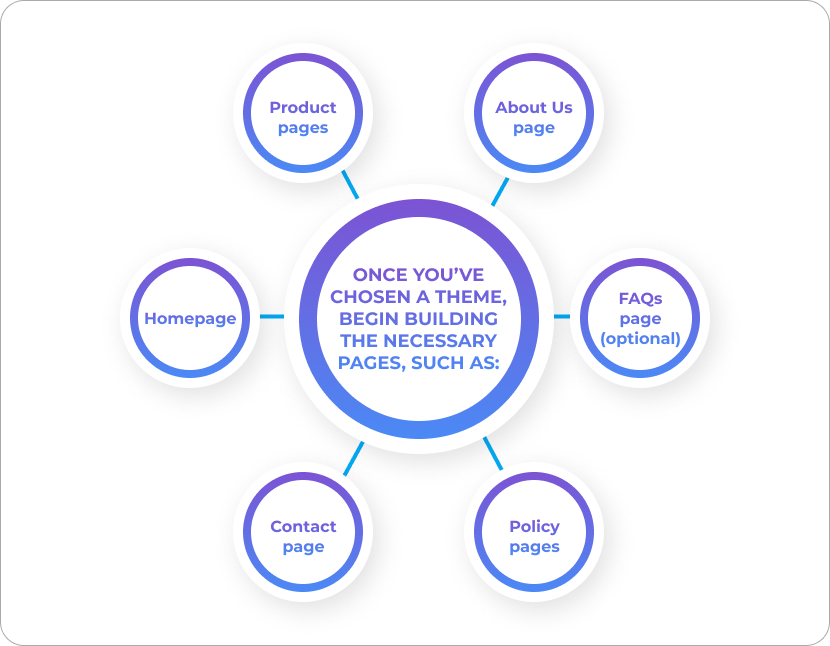How to Start an Ecommerce Business: A Simple 6-Step Guide
- 24.04.2024
- 28 views
- 10 min
Before developing an online store, it is important to lay a solid foundation
Creating a successful ecommerce venture requires dedication and effort. Before developing an online store, it is important to lay a solid foundation
In this extensive manual, we've compiled seven essential steps to guide you through the process of building, launching, and promoting your ecommerce store, complete with practical advice to enhance your chances of success.
Here's a detailed roadmap to kickstart your ecommerce journey effectively.
1. Identify Your Niche and Products to Sell
To launch an ecommerce venture, the initial step involves pinpointing your niche. This approach enables you to concentrate sharply on a specific market segment, dedicating more time and effort to understanding the unique needs of that particular audience.
When determining the ideal niche(s) for your enterprise, consider asking yourself the following questions:
- What areas do I possess expertise in? It's advantageous to operate within a niche where you already have knowledge or experience. This familiarity enables you to comprehend the target market and gauge the demand for various products effectively.
- Which niches are currently the most lucrative? Opting for a niche characterized by lower competition, high demand, and promising growth prospects is advisable. Explore some trending niches to gain insights.
- What are my personal interests or hobbies? Selecting a niche that aligns with your passions or pastimes can enhance your engagement and commitment to the business.
- What is my initial budget and available resources? Assess whether you can manage production costs independently or if alternatives like dropshipping or collaborating with manufacturers are more feasible. Additionally, determine if you can sustain a consistent supply of products and handle associated expenses.
Moreover, defining your preferred ecommerce business model can assist in refining your niche selection and shaping product concepts. Consider these six major ecommerce business models:

-
B2C (Business-to-Consumer) – online stores selling directly to customers.
-
B2B (Business-to-Business) – eCommerce between companies (e.g., wholesale platforms).
-
B2G (Business-to-Government) – businesses supplying products/services to governments via digital platforms.
-
C2C (Consumer-to-Consumer) – users selling to each other online.
-
C2B (Consumer-to-Business) – individuals selling products/services to businesses (e.g., freelancers, stock photos).
-
C2G (Consumer-to-Government) – citizens paying for government services online (e.g., taxes, permits).
Suppose you're keen on operating a B2B ecommerce venture focusing on industrial machinery and equipment. This broad category could be refined into specific sub-niches based on your expertise and preferences, such as woodworking machinery, textile machinery, or construction equipment.
Once you've pinpointed a few potential niches, it's essential to assess their demand and competition. Here's how you can do that:
- Analyze Research Reports: Seek out reputable sources for research reports to gain insights into the growth potential of these niches. These reports can provide valuable data on market trends, forecasts, and consumer behavior within your chosen sub-niches.
- Interview Industry Leaders: Connect with leaders and experts in the industrial machinery and equipment sectors to gain firsthand knowledge of market dynamics, customer preferences, emerging trends, challenges, and growth opportunities. Their insights can offer valuable perspectives and help you refine your business strategy.
- Conduct Competitive Research: Identify the major players in your chosen sub-niches and study their strategies. Analyze the products they offer, their influence on customer purchasing decisions, the marketing channels they utilize, and any unique selling propositions they employ. This information can guide you in positioning your business competitively within the market.
Galaxy IT company is a experts team who help for obtaining valuable market research data. Including market traffic, market size, traffic cost, key players, and top keywords.
By thoroughly evaluating the demand and competition within your chosen sub-niches, you can make informed decisions to effectively position your B2B ecommerce business for success in the industrial machinery and equipment market.
2. Conduct Target Audience and Competitive Research
Before diving into the development of your ecommerce store after finalizing your niche and product list, it's crucial to take a step back and thoroughly understand your target audience and competitors. This comprehensive understanding will serve as the foundation for tailoring your offering to address any unmet needs in the market.
Research Your Target Audience
A target audience is a group of people you want to aim your products, services, and/or marketing efforts at. It’s usually defined by traits like gender, age, interests, challenges, and goals.
Researching your target audience can give you insights into its challenges, pain points, and purchasing patterns. So you can then create messaging, offers, and marketing and advertising campaigns that resonate with your intended customer base.
Research Your Competitors
Take inspiration from your competitors' initiatives and enhance what they're doing effectively. Identify their best-selling products, the social media platforms they're active on, and the type of content they generate that engages their audience.
3. Source Your Product
There are various methods you can employ to source your products:
- Manufacture your own products: This option grants you full control over quality but demands a significant investment of time, money, and resources.
- Wholesaling: Involves purchasing products in bulk from a wholesaler, necessitating upfront investment and storage space.
- Dropshipping: Collaborate with a supplier who manages manufacturing, storage, packaging, and shipping, allowing you to focus on marketing and sales.
- Partnering with local manufacturers: Engage directly with local manufacturers who will produce goods according to your requirements and specifications.
Your chosen approach will dictate your subsequent actions.
For instance, if you choose to manufacture your own product, you’ll need to:
- Work on product design, development, and manufacturing.
- Purchase equipment.
- Hire people.
- Rent a manufacturing space.
If you partner with local manufacturers, you’ll need to:
- Evaluate different contenders
- Compare pricing and product quality
- Negotiate terms
- Discuss your specific requirements
4. Write a Business Plan
 Your e-commerce business plan should delineate your company’s objectives, strategies for attaining them, as well as your target demographic, financial forecasts, and operational framework.
Your e-commerce business plan should delineate your company’s objectives, strategies for attaining them, as well as your target demographic, financial forecasts, and operational framework.
This document serves as both a guide and a compass for your enterprise, addressing critical business-related inquiries.
Below is a template you can utilize to craft a comprehensive business plan:
Now is the opportune moment to select a business name and address any legal obligations linked to setting up your online store.
You'll also need to apply for the requisite trade licenses and sales tax certifications, along with health, environmental, and safety permits.
To create your own online store, you can contact the developers of our company or do it yourself. Read more about the principles of creating an e-commerce website in our post: Custom eCommerce web development in 2024 - everything you need to know
5. Build Your Ecommerce Store
I. Find the Right Domain Name
A domain name is a part of your site URL that identifies what your business is. Like this:
- While it's recommended to use your business name as your domain name, it's not mandatory.
- You can check the availability of domain names using a domain name registrar like GoDaddy or a domain name search service like Instant Domain Search.
II. Choose a Website Builder and Web Host
An ecommerce website builder is an online platform that enables you to establish and oversee your online store without requiring advanced technical skills.
Many website builders provide drag-and-drop functionality and a variety of customizable templates, simplifying the process of creating an ecommerce store without the need for coding expertise.
III. Decide Your Website Layout
Now is the time to design the core of your online business - your ecommerce store. Website builders offer a wide range of both free and paid customizable themes that you can install with just a few clicks.
Experiment with different themes to discover what suits you best. Choose a theme that allows for extensive customizations.
Here’s an example:
- If you sell personalized T-shirts, select a theme that enables you to custom-code a feature allowing customers to add text or upload images for personalization. You can also custom-code a feature that allows them to preview their customizations before making a purchase.
Once you’ve chosen a theme, begin building the necessary pages, such as:

Important
Build your pages with search engine optimization (SEO) in mind to help your online store rank well in search engines.
IV. Set Up a Payment Gateway
The primary goal of an ecommerce business is to generate online sales. Therefore, you'll need to establish a payment gateway to accept payments from customers on your website.
A payment gateway is the front-end technology that enables secure and efficient processing of online customer transactions.
Luckily, many website builders offer native payment processing systems you can quickly set up on your online store. You can also utilize third-party ecommerce plugins like Stripe or Razorpay.
Before we proceed to marketing tactics, let’s address a common question: How long does it take to start an ecommerce business and get an online store up and running?
There’s no single, straightforward answer to this question.
As you can see, the timeline for setting up your ecommerce business will depend on various factors such as your product-sourcing method and the duration required to obtain the necessary licenses and permits. Additionally, factors like available resources, website-building, and other setup processes will play a role.
6. Market Your Ecommerce Business
Once you’ve established your ecommerce store, it’s essential to spread the word to attract potential customers.
But how?
By employing digital marketing strategies such as SEO, social media marketing, paid advertising, etc.
Let's dive into the most popular digital marketing strategy - SEO promotion.
I. SEO for eCommerce Website
Search engine optimization (SEO) involves a series of processes aimed at organically enhancing your website’s visibility in search engines.
Utilizing relevant keywords in your content is crucial in this regard.
By optimizing your ecommerce website with appropriate keywords, you can attract potential customers who are using search engines to discover products like yours.
For instance, suppose your ecommerce store specializes in projectors and equipment. Through SEO, you can improve the likelihood of your website appearing in organic search results when users search for terms like “projectors and equipment” or related keywords.
So, how do you identify the best keywords for your ecommerce store? Let's take a look at one of our cases:
Using the Ahrefs and Semrush tools, we collected a list of competing websites, after which we received a list of information that helped us write a high-quality promotion strategy and action plan.
We categorized the information we needed:
- Keywords for which competing sites are ranked;
- A list of the most competitive pages from which competitors receive traffic;
- We analyzed external links;
- We compiled a list of all E-E-A-T factors that later helped us to consolidate our success.
Note
Always focus on keywords from the list that make sense to you. Some of them may not be relevant to your business. Others may be too difficult to rank for.
II. SEO results
As a result, in 16 months of work, we have reached the mark of more than 100k visits from free organic search


III. Gear Your Ecommerce Business Up for Healthy Growth
Launching your ecommerce business is just the beginning of your journey.
It's important to consistently test various digital marketing strategies to gain a better understanding of what works best for your business and what doesn't. Additionally, staying updated on the latest ecommerce trends and competitors' marketing strategies is crucial for staying ahead in the game.









